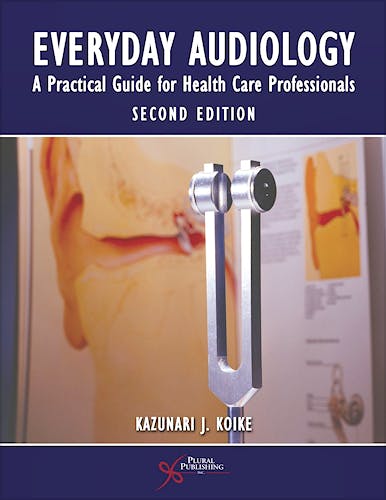

No hay productos en el carrito



Everyday Audiology. a Practical Guide for Health Care Professionals
Koike, K.
2ª Edición Junio 2013
Inglés
Tapa blanda
224 pags
418 gr
18 x 26 x 2 cm
ISBN 9781597565455
Editorial Plural Publishing Inc
LIBRO IMPRESO
-5%
57,05 €54,20 €IVA incluido
54,86 €52,12 €IVA no incluido
Recíbelo en un plazo de
2 - 3 semanas
Description
Everyday Audiology, Second Edition is an invaluable guide for clinicians involved in the care of patients with hearing impairment or balance disorders. Originally written for ENT residents, it has also become a useful resource for other health care professionals who need to synthesize audiologic test results and come up with one cohesive clinical diagnosis. This includes otolaryngologists, family medicine physicians, pediatricians, medical students, audiologists, audiology students, teachers of the hearing impaired, hearing instrument specialists, speech-language pathologists who work with hearing- impaired children, and even physical therapists who provide rehabilitation to patients with balance disorders.
The book contains clinically relevant norms and values that are extremely useful for clinical interpretation. Drawn from lectures given to otolaryngology-head and neck surgery residents and case reports conducted by clinical audiologists at West Virginia University School of Medicine, the book is designed for easy consumption of essential information. Key concepts are presented on left-hand pages and supporting and tabular material on the right.
The book is divided into five parts:
· Part I: Evaluation of Hearing Disorders
· Part II: Evaluation of Balance Disorders
· Part III: Rehabilitation of Hearing Disorders
· Part IV: Otologic/Audiologic Differential Diagnosis
· Part V: References and Notes
For the second edition, there is an addition of an entirely new section. Otologic/audiologic diagnoses that are commonly seen in otology and audiology clinics are presented with a battery of associated audiologic examinations . In this new section (Part IV), the diagnostic code, commonly known as International Classification of Diseases 9th Revision Clinical Modification (ICD-9-CM), is conveniently provided under each case as a reference.
Frequently used audiology terminology and significant clinical criteria are printed in bold. The Current Procedural Terminology (CPT) code, if available, is listed under each test procedure. This book has been found to be helpful in preparation for periodic in-service exams for ENT residents, the ASHA praxis exam for AuD students, and the Step 2 clinical exam for medical students.
Audience
Primary Subject: Otolaryngology-Head & Neck Surgery / General
Secondary Subject: Audiology / General
Audience Level: Professional
Table of Contents
Foreword by Stephen J. Wetmore, M.D, M.B.A.
Preface
Overview
Part I: Evaluation of Hearing Disorders
History
Audiogram
Hearing Level
Calibration and Equal-Loudness Contours
Degree of Hearing Loss
The Effects of Hearing Loss
Type of Hearing Loss
Masking
Effective Masking
Speech Reception Threshold and Discrimination
Tuning Fork Testing
Tympanogram
High-Frequency Tympanogram
Acoustic Reflex
Understanding Acoustic Reflex Patterns
Visual Reinforcement Audiometry (VRA)
Stenger Test
Auditory Brainstem Response (ABR)
Neurologic ABR Interpretation
Threshold ABR
Auditory Steady-State Response
Electrocochleography (ECoG)
Otoacoustic Emissions (OAE)
Transient-Evoked Otoacoustic Emissions (TEOAE)
Distortion-Product Otoacoustic Emissions (DPOAE)
Central Auditory Processing (CAP)
CAPD Intervention
Part II: Evaluation of Balance Disorders
Dizziness Handicap Inventory (DHI)
Electronystagmography (ENG)
Saccade
Tracking (Pursuit)
Gaze
Positional
Optokinetic (OPK)
Dix-Hallpike Maneuver
Caloric
Unilateral Weakness
Bilateral Weakness
Directional Preponderance
Rotational Chair
Computerized Dynamic Posturography (CDP)
Clinical Test of Sensory Interaction on Balance (CTSIB)
Vestibular Rehabilitation
Vestibular-Evoked Myogenic Potentials (VEMP)
Part III: Rehabilitation of Hearing Disorders
Hearing Aid Evaluation (HAE)
Size and Style of Hearing Aids
Assistive Listening Devices
Cochlear Implant
Criteria for Cochlear Implant Candidacy
Success Hierarchy from Cochlear Implant
Methods of Rehabilitation
Summary of Audiologic Tests for Common Ear Disorders
PART IV: Otologic/Audiologic Differential Diagnosis
Section A: Outer and Middle Ear
Congenital Aural Atresia
Eustachian Tube Dysfunction/Otitis Media
Perforated Tympanic Membrane
Cholesteatoma
Otosclerosis
Acoustical Mechanism of the Outer and Middle Ear
Section B: Inner Ear
Hereditary Hearing Loss
Basics of Hearing Loss Inheritance
Unilateral Hearing Loss
Management of Educationally Significant Hearing Loss
Meniere’s Disease
Noise Induced Hearing Loss
Hearing Conservation Program
Compensation for Hearing Loss
Pseudohypacusis
Electrophysiologic Estimates of Hearing Loss
Tinnitus
Ototoxicity
Reporting Adverse Events from Ototoxicity
Presbycusis
Communicating with Someone with a Hearing Loss
Section C: Retrocochlear
Acoustic Neuroma
Abnormal Auditory Perception (Auditory Neuropathy/Dyssynchrony)
Section D: Facial Nerve and Balance
Bell’s Palsy
Benign Paroxysmal Positional Vertigo
Vestibular Neuronitis
Appendix
Syndromes and Diseases Associated with Hearing Loss
PART V: References and Notes
Index
About the Author
Kazunari J. Koike, PhD, is Director of Audiology and Professor of Otolaryngology at West Virginia University School of Medicine for the past 24 years. He was born in Tokyo, Japan and earned a Bachelor’s degree in Linguistics at Sophia University in Tokyo as well as Master’s and PhD degrees in Audiology at the University of Tennessee in Knoxville, TN. He holds the Certificate of Clinical Competence in Audiology (CCC-A). Dr. Koike evaluates patients in a tertiary care ENT clinic on a daily basis, and his expertise encompasses all areas of diagnostic and rehabilitative audiology.
© 2025 Axón Librería S.L.
2.149.0